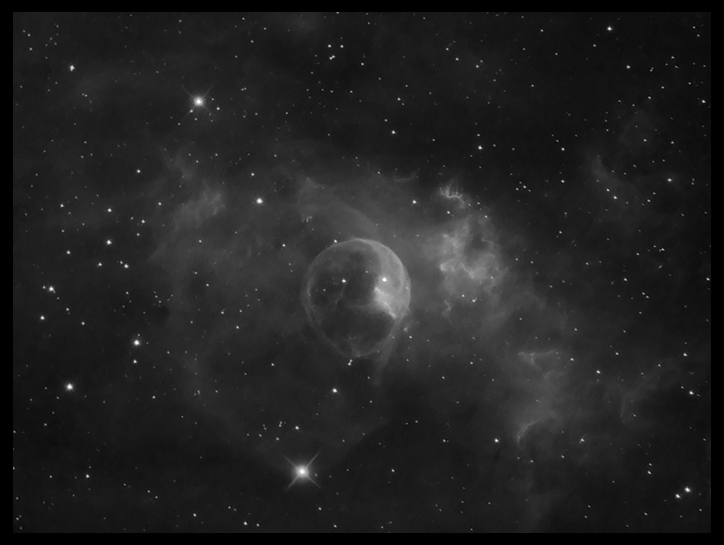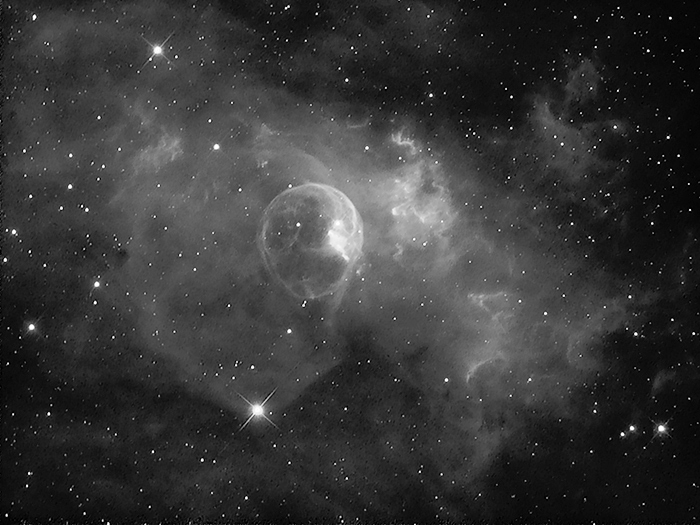10/31/2011. The CCDWare calculator mentioned on the previous page suggests that I should be making longer subs in H-a, as suspected from the histograms of my 900s frames. CCDWare says 30.6 minutes would be ideal; call it 30m or 1800s. Building a library of darks means I can do such long subs without committing to spending a lot of time taking darks on nights better spent collecting fossilized light. So: add a row to the library table when you feel like it (tonight will do, during the first half of the LSU Alabama game).
I got some Chameleon video of the Moon with the AT10 in twilight tonight both at native FL and with a barlow. Use it straight through, no diagonal. Native focus is out an inch and change from the ST2000 with OAG chain, but with the barlow threaded into the 1.25-inch snout, focus is extended three inches or so. It takes some hunting, but the results looked promising. Except that by the time I got decent focus, I was shooting through a pine tree.

Clavius
PGR Chameleon
300 frames, ~3ms
AT10RC + barlow on 1.25-inch snout
Nothing special really, but the image is significant in that it's a planetary image made with the Ritchey-Chretien through a pine tree in deep twilight — it verifies that the planetary camera can reach focus and that it's worth some time to work out methods of using this telescope for solar system photos. Try lower gain with longer exposures next time. Focus like a maniac. And avoid the tree.
I put the deepsky package back in place and took 1800s darks to prepare for longer exposures of the Bubble. I'd made five darks when NGC 7365 cleared the trees. My wide-range focus moves to accomodate the video camera must have loosened a setscrew between Robofocus and the focuser, because commands to move the camera were at first unreliable and then ineffective (yes, fixed next morning). I manually focused to about 1.6 arc seconds (got lucky), but it didn't occur to me to use the focus lock on the telescope. With the Robofocus motor presumably un- or only loosely attached, the weight of the CCD might cause creep during long exposures, especially at low zenith angles. Anyway, I took H-a data during the second half of the game in 30 minute gulps:

NGC 7365, the Bubble Nebula in Cassiopeia
4x1800s, 7nm H-a filter
5 darks / no flat / no bias
So... that worked very well despite marginal and likely shifting focus. Shortly after LSU won (in OT), the sky began to close down, so I shot more and colder darks. By the time the night was over, my calibration library looked like this (note the new row at the bottom and the 16 additional -30, 300s frames intended for casual luminance and RGB efforts):
chip temp °C: |
-20 |
-25 |
-30 |
-35 |
-40 |
Bias frames: |
16 |
|
16 |
16 |
16 |
300s darks: |
|
|
25 |
|
|
900s darks |
|
12 |
31 |
4 |
8 |
1800s darks |
|
|
5 |
|
10 |
11/6/2011. Early in the evening, I again collected darks and pounced on the Bubble Nebula as soon as it cleared Bird Feeder Tree. The Clear Sky Clock promises better than average seeing, mediocre transparency, and thinning clouds (what few there are) as the night goes on. The find-and-focus and fine-focus runs confirm that the seeing is very good (PSFs 1.3 arc seconds or less), so let's just see what happens if I lock onto a guide star and take 1800s narrow-band H-a data through the night. Damn the moonlight, full speed ahead. In anticipation of this opportunity, I took five more 1800s darks at -30°C. My dark frame for the evening will be a sigma clip of 10 darks.

NGC 7635
7 x 1800s, 7nm H-a
(10 darks)

NGC 7635
7x1800s, 7nm H-a
1x300s RGB
I collected an additional 90 minutes of H-a data of the Bubble while working up the photos above, so better is yet to come. These are pushed a little harder than I'd like (the monochrome rendition especially) just to see what shows up in 30 minute subs. I'll calm down and produce something lovely soon. Later, I slewed to M1 (which landed dead center on the chip; thank you Roland) and took 300s of RGB in the moonlight before leaving the telescope to take H-a until dawn.
Messier One is the wreckage of a star:

M1, a supernova remnant in Taurus
6x1800s Ha, 1x300s RGB
A little noisy, a little thin, color balance is a little off, but it's only 3 hours of H-a used as luminance and only 5 minutes of RGB, through haze and moonlight at that. Promising is the word. I thought at first that the blue cast to the partially processed image indicated that the sky must have been momentarily clearer while I was exposing through the blue filter. Then I realized that the moonlit sky is blue, as the daylit sky is; it's just too faint to trigger color receptors in the eye (at least in my eye except sometimes at full phase). D'oh! is also the word.
Except where noted, deep-sky photos are made with an SBIG ST2000XM CCD behind a 10-inch Astro-Tech Ritchey-Chretien carried on an Astro-Physics Mach1GTO. The CCD is equipped with Baader LRGB and 7nm H-a filters. A Meade DSI Pro monochrome camera looking through a modified Orion off-axis guider keeps the OTA pointed in the right direction. The imaging camera is controlled via Nebulosity 2; the guide camera is operated by PHD Guide 1.13, both by Stark Labs. The stock focuser on the AT10RC has been augmented with Robofocus 3.0.9 using adapters turned on the lathe downstairs. Maxim DL5.12 performs image calibration, alignment, and stacking; Photoshop CS4 and FocusMagic 3.0.2 take it from there. Gradient Xterminator by Russell Croman and Astronomy Tools by Noel Carboni see their share of work, too.
:: top ::